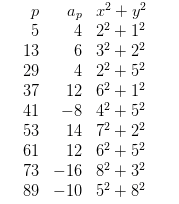I was reading this blog by Evan Chen about complex multiplication. He's discussing Sato-Tate Conjecture. We can have elliptic curve $E/\mathbb{Q}$ and solve it over finite fields.
\begin{eqnarray*}
a_p &=& (p+1) - \#E(\mathbb{F}_p)\\
a_p &=& 2 \sqrt{p} \cos \theta_p \
\end{eqnarray*}
Sato-Tate is going say that $\theta_p$ is distributed like some kind of sine measure
Sato-Tate Fix an elliptic curve $E/\mathbb{Q}$ which does not have Complex Multiplication (over $\mathbb{C}$). As $p$ varies across unramified primes the probability that $\theta_p \in [a,b]$ is: $$ \frac{2}{\pi}\int_a^b \sin^2 \theta \, d\theta $$ In other words $\theta_p$ is equidistributed with respect to $\mu = \sin^2 \theta \, d\theta$
If there is complex multiplication, there is a relationship to splitting of primes. $$ E : y^2 = x^3 - 17x \quad\text{ has }\quad \text{End}(E) \simeq \mathbb{Z}[i] $$ Apparently there are "bad primes" $p = 2, 17$. Chen observes that $a_p = 0$ for $p \in 4\mathbb{Z}+3$ and states a CM Sato-Tate conjecture.
CM Sato-Tate Let $E/\mathbb{Q}$ be an elliptic curve with CM by $\mathcal{O}_K$. Let $\mathfrak{p}$ be an unramified prime over $\mathcal{O}_K$:
- If $\mathfrak{p}$ is inert then $a_\mathfrak{p} = 0$ (i.e. $\theta_\mathfrak{p} = \frac{\pi}{2}$)
- If $\mathfrak{p}$ is split then $\theta_\mathfrak{p}$ is uniform across $[0, 2\pi]$
In his example $a_p$ is also related to the splitting of $p \in \mathbb{Z}[i]$
This looks an awful lot like the equidstibution of primes $\mathfrak{p} \in \mathbb{Z}[i]$. Is there always this link between complex multiplication and the angles of primes? He points to Deuring's Theorem
Let $E/\mathbb{Q}$ have CM by $\mathcal{O}_K$. Then $$L(s, E/K) = L(s, \xi) L(s, \overline{\xi})$$ for a Hecke Grossencharacter $\xi$.
And lastly I learned that both of these things have Euler products:
$$ 1 - \frac{a_\mathfrak{p}}{(N\mathfrak{p})^{s + \frac{1}{2}}} + \frac{1}{(N\mathfrak{p})^{2s }} = \left(1 - \frac{\xi(\mathfrak{p})}{(N\mathfrak{p})^s} \right)\left(1 - \frac{\overline{\xi}(\mathfrak{p})}{(N\mathfrak{p})^s} \right)$$
Is Hecke equidistribution a special case of Sato-Tate? Certainly there is a Grossencharakter:
\begin{eqnarray*} a_\mathfrak{p} &=& 2 \sqrt{N\mathfrak{p}} \cos \theta_\mathfrak{p}\\ \xi(\mathfrak{p}) &=& \exp (i \theta_\mathfrak{p}) \end{eqnarray*}
Chen doesn't quite say this map is just the angle $p \mapsto a+bi = \sqrt{a^2 + b^2} e^{i\theta}$. Maybe it's not?
$$\mathfrak{p} \mapsto \left\{ \begin{array}{cc} e^{i\theta_\mathfrak{p}} & \text{gcd}(N\mathfrak{p}, N) =1 \\ 0 & \text{gcd}(N\mathfrak{p}, N) >1 \end{array}\right. $$
Basically, we have read his whole blog. I noticed this looks like Fermat's two-squares theorem and I kept reading. His discussion makes it no less mysterious.
In the very broadest strokes, when does Sato-Tate relate to the splitting of primes in this way?
Higher Rank
What do those Satake parameters have to do with the splitting of primes? In our case $a_p = 2x$ where $p = x^2 + y^2$. Perhaps there is a higher-rank analogue. Originally I was merely going to ask about other CM elliptic curves.
Which compact group is being used when we discuss elliptic curves over complex multiplication? I think it's $G = SU(2)$.
In the non-CM case, the splitting of primes play no role and I wonder what is happening there? Perhaps the additional symmetry is restricting the location of the angles $\theta_\mathfrak{p}$.

